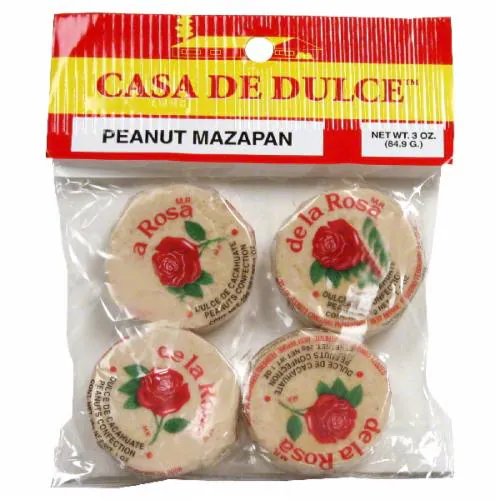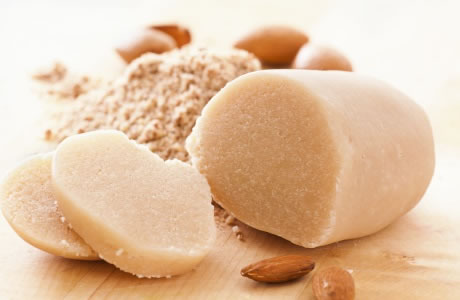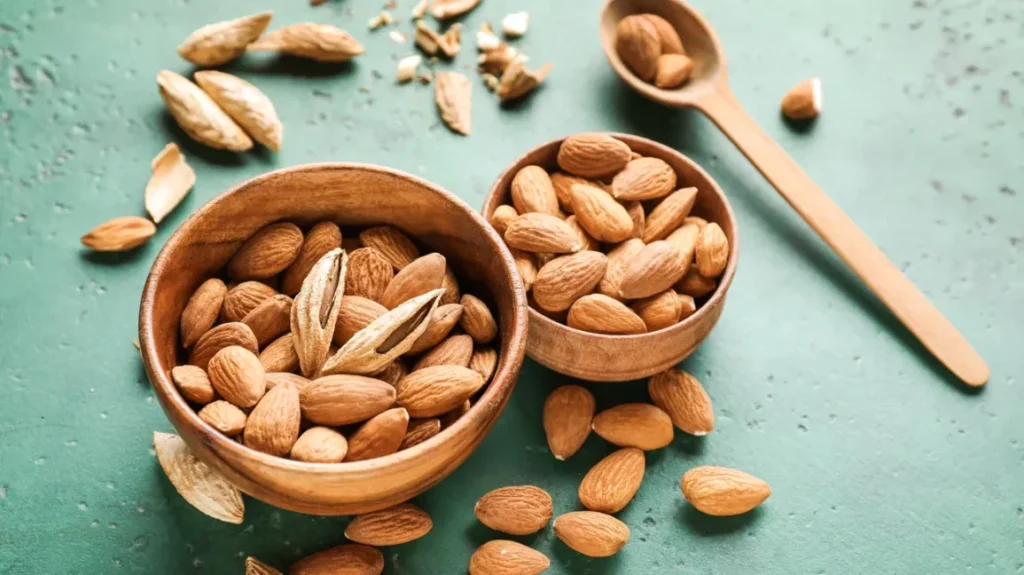Mazapan is a peanut-based Mexican candy with some protein and healthy fats but high in sugar and calories, best enjoyed occasionally.
This article delves deep into mazapan’s nutrition facts, its potential health benefits, the possible drawbacks, and tips for enjoying it in a balanced diet.
What Is Mazapan?

Mazapan has origins in both Mexican and European cultures, though it differs slightly between regions. The Mexican version of mazapan is made from ground peanuts and sugar, while the European marzipan, often called “mazapán” in Spain, is typically made from almonds and sugar. Because peanuts are more affordable and accessible in Mexico, they became the preferred ingredient, leading to the distinct version we know today.
In Mexico, mazapan is typically sold as a small, round, disk-shaped candy wrapped in thin paper or plastic. It is easily crumbled, which adds to its appeal, but also makes it delicate to handle. Due to its rich peanut flavor and melt-in-the-mouth texture, it has become a popular treat both in Mexico and beyond.
Mazapan Ingredients and Caloric Content:
The beauty of mazapan lies in its simplicity. With just a few ingredients, it manages to deliver a rich, satisfying flavor that appeals to candy lovers. Here’s a breakdown of the typical ingredients and the nutritional content you can expect.
Ingredients:
- Peanuts: The primary ingredient in mazapan is ground peanuts, which form the base of the candy. They provide protein, healthy fats, and essential nutrients.
- Sugar: Added for sweetness and structure, sugar binds with the ground peanuts to give mazapan its unique, crumbly texture.
- Additional Flavorings or Stabilizers: Some brands may add natural or artificial flavorings or stabilizers to enhance taste and texture.
Also Read: Foxtail Nutrition Menu – A Comprehensive Guide!
Mazapan Nutrition Facts (Per 28-Gram Serving):
For a standard serving size of 28 grams (approximately one piece), here’s a nutritional snapshot:
| Nutrient | Amount |
| Calories | 140-160 kcal |
| Total Fat | 7-10 grams |
| Saturated Fat | 1-2 grams |
| Cholesterol | 0 grams |
| Sodium | 0-15 mg |
| Total Carbohydrates | 17-20 grams |
| Dietary Fiber | 1-2 grams |
| Sugars | 12-15 grams |
| Protein | 4-5 grams |
Mazapan’s nutritional profile is largely derived from its two main ingredients, peanuts and sugar, each contributing to its caloric and macronutrient content. It’s rich in fats (mostly unsaturated), moderate in protein, and high in sugars.
Health Benefits of Mazapan:

Although mazapan is a treat, it has some notable health benefits, primarily due to its peanut content. While it should be enjoyed in moderation, there are some positives to consider:
Good Source of Plant-Based Protein:
Each serving of mazapan provides about 4-5 grams of protein, a relatively high amount for a candy. Plant-based protein is beneficial for muscle development, tissue repair, and cellular health. This makes mazapan a more filling option than most candies, as protein helps keep you satiated.
Healthy Fats for Heart Health:
Peanuts are rich in monounsaturated fats, which are considered “good fats.” Monounsaturated fats can help lower LDL cholesterol (the “bad” kind) while potentially raising HDL cholesterol (the “good” kind), promoting heart health. A serving of mazapan has around 7-10 grams of total fat, with a good portion of it coming from monounsaturated sources.
Also Read: GooGpop Mango Junior Pops Nutrition Label – A Comprehensive Guide!
Nutrient-Dense with Vitamins and Minerals:
Mazapan contains nutrients naturally found in peanuts, such as:
- Magnesium: Important for bone health, muscle function, and energy production.
- Phosphorus: Essential for strong bones and teeth and assists in energy storage.
- Vitamin E: An antioxidant that protects cells from oxidative stress.
These nutrients make mazapan a somewhat nutritious treat, especially when compared to other sugar-heavy candies.
High in Antioxidants

Peanuts contain several antioxidants, including resveratrol, which has been studied for its potential to reduce inflammation and protect against chronic conditions like cardiovascular disease. While the antioxidant content in mazapan isn’t as high as in whole peanuts, some beneficial compounds are still present.
Potential Drawbacks of Eating Mazapan:
Despite the benefits, there are some drawbacks to consider when consuming mazapan regularly or in large quantities. Here’s what you need to know:
High in Calories and Sugar:
Mazapan is calorie-dense due to its high fat and sugar content. With around 140-160 calories per piece, it can contribute significantly to daily caloric intake, especially when eaten in large amounts. The high sugar content (about 12-15 grams per piece) can also contribute to blood sugar spikes, making it less suitable for those monitoring their blood glucose levels.
Also Read: Grounded Coffee Madison Nutrition – A Nutritional Overview from Madison!
Risk of Peanut Allergies:
One of the main concerns with mazapan is its peanut content, which poses a risk for those with peanut allergies. Even a small amount can trigger a severe reaction, so it’s important to be aware of this when sharing or handling mazapan around those with allergies.
Low Nutritional Density Compared to Whole Foods:

While mazapan does provide some protein, fiber, and essential nutrients, it’s not as nutrient-dense as whole foods like fresh fruits, vegetables, and whole grains. Eating too much mazapan without balancing it with other nutrient-rich foods may result in a diet low in essential vitamins and minerals.
Possible Presence of Additives:
Depending on the brand, some mazapan products may contain additional additives or preservatives. While generally safe, some individuals may prefer a cleaner ingredient list or may have sensitivities to artificial additives. It’s a good idea to check the label if you’re concerned about added ingredients.
How Mazapan Compares to Other Sweets:
Mazapan is unique in that it combines the characteristics of a nut-based snack with those of candy, making it a hybrid treat. Here’s how it stacks up against other sweets:
- Higher in Protein: Thanks to the peanut content, mazapan has more protein than most sugary candies, which are usually high in sugar and fat but low in protein.
- Contains Healthy Fats: Unlike many sweets that use unhealthy oils or trans fats, mazapan’s fats come from peanuts, providing healthier, unsaturated fats.
- High in Sugar: While it offers some nutritional value, mazapan is still high in sugar, which is a drawback when compared to healthier snacks like fruits or whole-grain options.
Also Read: Wyoming Supplemental Assistance Nutrition Program Waiver – A Comprehensive Guide!
Tips for Enjoying Mazapan in a Healthier Way
Mazapan can be part of a balanced diet if consumed thoughtfully. Here are some ways to enjoy it while minimizing potential downsides:
- Limit Portion Size
A single serving of mazapan (about one piece) has a considerable amount of calories and sugar. To avoid overindulging, stick to one piece and pair it with a balanced snack, such as fresh fruit, to keep you fuller for longer.
- Balance with Fiber-Rich Foods
Pairing mazapan with foods high in fiber, like apples, carrots, or a small salad, can help slow the absorption of sugar and promote stable blood sugar levels. Fiber is also helpful for digestion and keeping you satisfied.
- Choose Lower-Sugar Options When Available
Some specialty or artisanal brands offer lower-sugar versions of mazapan. These alternatives can be a great way to enjoy the treat with less impact on blood sugar levels.
- Enjoy as an Occasional Treat
While mazapan has some health benefits, it’s best enjoyed in moderation due to its high calorie and sugar content. Treat it as an occasional indulgence rather than a daily snack.
FAQs:
1. What is mazapan made of?
Mazapan is primarily made from ground peanuts and sugar, with some brands adding natural or artificial flavorings or stabilizers.
2. How many calories are in a serving of mazapan?
A standard 28-gram serving of mazapan contains about 140-160 calories.
3. Is mazapan healthy?
Mazapan provides protein, healthy fats, and some vitamins, but it is also high in sugar and calories, so it’s best enjoyed as an occasional treat.
4. Can people with peanut allergies eat mazapan?
No, mazapan contains peanuts and should be avoided by individuals with peanut allergies.
5. How can I enjoy mazapan in a healthier way?
Limit portion size, pair with fiber-rich foods, and choose lower-sugar versions if available to balance its impact on your diet.
Conclusion
In conclusion, mazapan is a simple yet indulgent Mexican treat that combines the richness of peanuts with the sweetness of sugar. While it offers some protein and healthy fats, its high calorie and sugar content means it should be enjoyed in moderation. For those looking to savor it healthily, consider limiting portions and pairing with fiber-rich foods to balance its impact on your diet.